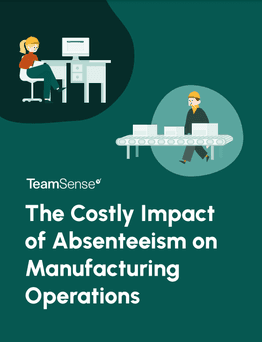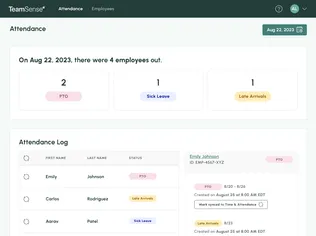When to HR with AI (and When Not To)!
Understanding AI in HR – What It Means for You
Artificial intelligence is reshaping the world we live in—and the human resources field is no exception. From recruiting to employee engagement, HR teams are using AI tools to automate processes, drive new efficiencies, and generate insights from their data.
Even so, as an HR professional, this all might feel a little anxiety-inducing. If machines can be trained on the work that you do, what does that mean for your role?
Never fear: In this guide, we’ll talk through how you can use AI tools for HR professionals to enhance your HR role and make yourself even more indispensable to your workplace. We’ll showcase tools and platforms that can streamline HR workflows, helping you do your job more efficiently and drive greater value to your organization.
What is AI and How Does It Fit Into HR?
Generally speaking, artificial intelligence refers to various technologies that can perform tasks that typically require human intelligence. Some common forms of AI include:
Machine learning: These systems learn from vast quantities of training data, which are used to build algorithms that solve real-world problems.
Automation: AI automation technologies optimize processes to complete tasks faster, continually learning from the data to improve outcomes.
Generative AI: Generative AI can be used to create new content, including text, images, and sound, based on materials provided in training data.
While older HR software may contain basic automations, current AI tools for HR professionals use Machine Learning technology to continually adapt to their environment, ensuring that they “learn” more as they work. Modern HR AI tools can be used to spotlight and fix inefficiencies in your processes, and to develop new content that’s customized for your business needs. Today’s AI tools get smarter the more often you use them—giving you genuine insights that you can use to improve your company’s HR function.
Common Misconceptions About AI in HR
As you start to integrate AI into your HR workflows, you may have some preconceived notions about it, whether positive or negative. Here are some of the most common myths about AI, and the truth behind them:
“AI will take my job” → Reality: AI is a tool, not a replacement.
Seventy-two percent of workers trust AI to bring value to their work processes.“AI decisions are completely unbiased” → Reality: AI can inherit human biases if not monitored properly.
AI algorithms are only as good as the data they’re trained on. It’s important to use a rigorous process for choosing AI tech vendors, and to regularly audit your AI tools’ output for signs of bias.
“AI is too technical for HR teams” → Reality: Most AI tools are designed for non-tech users.
The best AI tools for HR professionals are intuitive to use, and require minimal or no advance training. (That said, it’s never a bad idea to familiarize yourself with the technology.)
TL;DR Summary
AI is revolutionizing HR, from recruiting to employee engagement, by automating processes and generating insights. While some worry about job security, AI is a tool to enhance, not replace, HR roles.
Key Takeaways:
- AI in HR: AI includes machine learning, automation, and generative AI, helping HR teams optimize workflows and improve efficiency.
- Common Myths: AI won’t replace HR jobs but can inherit biases if not monitored. Most tools are user-friendly, even for non-tech professionals.
- HR AI Tools:
- Recruiting: AI-powered ATS, chatbots, and candidate ranking tools (e.g., Greenhouse, HireVue).
- Employee Engagement & Performance: AI-driven surveys, performance tracking, and L&D programs (e.g., CultureAmp, LinkedIn Learning).
- HR Administration & Compliance: AI automates payroll, compliance, and workforce analytics (e.g., Gusto, Deel, Visier).
Adapting to AI in HR:
- Training: Free & paid AI courses (e.g., AIHR Academy, Coursera).
- Implementation: Start small—automate tasks like scheduling, then expand usage.
- Overcoming Resistance: Educate teams, create AI policies, and emphasize AI as a support tool.
The Future of AI in HR:
- Hyper-personalized employee experiences
- AI-driven workforce planning
- HR shifting to strategic, people-focused roles
- Ethical AI governance to prevent bias and ensure compliance
Practical AI Tools for HR Professionals
As you start to get more comfortable with AI tools, you’ll find a range of options for supporting you in every facet of your role, wherever you sit in the HR org. Learn more about the different AI tech solutions that can support every use case.
AI Tools for Recruiting and Hiring
Using an AI-powered applicant tracking solution (ATS) can help you consolidate hours of manual labor into minutes, with automated workflows that help you promote job listings, collect resumes in a centralized database, and send out interview requests and other communications with candidates. Many solutions also enable you to automatically screen for filtered keywords or skills and rank candidates based on your criteria, helping you narrow down your candidate pool. You can save time on candidate interactions by using a solution with a built-in AI chatbot, which uses natural language processing to answer candidates’ questions about job roles, company policies, and interview process. All of this can help you accelerate the hiring process, so you can onboard more high-quality employees with ease.
Recommended solutions:
Greenhouse is an all-in-one ATS with customizable workflows and structured interview kits
HireVue is a video interview and assessment solution with AI-driven candidate ranking
Paradox offers recruitment automation, with an AI-driven chatbot
Humanly supports DEI-focused recruiting, with bias reduction tools and conversational AI tools
AI Tools for Employee Engagement & Performance
AI tools aren’t just used for hiring—they’re also ideal for measuring engagement and performance among your existing pool of employees. These solutions can use analytics insights to help you track and assess progress, and deliver tailored recommendations for performance improvement. When training and upskilling employees, you can use generative AI L&D solutions to develop customized learning programs, and assess their skill level as they progress.
Recommended solutions:
CultureAmp for AI-powered pulse surveys & sentiment analysis
LinkedIn Learning for AI-driven learning & development
Lattice for AI-enhanced performance management
AI Tools for HR Administration & Compliance
Dealing with paperwork and data entry is a major time suck for HR professionals—and one that you can greatly reduce with the help of tools that support HR administration and compliance. You can make use of workflow automation tools to help you streamline common workflows including payroll and benefits; use Gen AI tools to create and customize HR documents; and use AI-driven workflow analytics solutions to inform your decision-making.
Recommended solutions:

The Costly Impact of Absenteeism on Manufacturing Operations
Learn how chronic, unplanned absenteeism is a costly impediment to manufacturing productivity and efficiency, and how you can reduce absenteeism.
How HR Professionals Can Learn & Train on AI
If you’re beginning to see the benefits of embracing AI tools for HR, but you want to proceed with caution, it’s a great idea to explore learning opportunities focused on the foundational elements of AI and how it can be used in the human resources industry. From there, you’ll feel more comfortable choosing the right solutions that fit your needs, and can gain confidence in your ability to follow trends in AI technology to ensure that you’re making the right choices for your business.
Free & Paid AI Courses for HR Professionals
When you’re just getting familiar with AI technology, it can be overwhelming deciding where to start. Consider diving into online resources that provide an ELI5 (“explain it like I’m five”) version of AI technology, so that you can understand what it’s built on. From there, you can focus on courses that showcase how to enhance your HR role with the support of AI technology, which your workplace will likely be happy to sponsor on your behalf.
Recommended resources:
AI for Everyone by Andrew Ng on Coursera for a free, beginner-friendly course
AIHR Academy for paid access to 13 AI certificate programs in HR
LinkedIn Learning for paid access to over 600 interactive video courses showcasing elements of AI technology
How to Incorporate AI Training Into Your HR Role
Once you’ve spent some time studying the basics of AI technology and how it can inform your work, you’ll be ready to start integrating it into your day-to-day operations.
Get started by embracing low-risk AI tools, such as scheduling assistants that can save time and automate workflows. Next, test out generative AI tools that can help you draft emails and policy documents. Make sure that you conduct a thorough manual review of each document, to ensure that it meets your brand’s standards and includes the relevant information you need, and tweak as necessary before sharing the content.
When rolling out AI technology to your team, make sure that you provide training opportunities for them to become comfortable and go over any questions in advance. By ensuring familiarity, you’ll be poised for much higher adoption rates.
How to Stay Up to Date with AI in HR
The AI landscape is changing at breathtaking speed—so, even once you’re starting to feel more familiar, what should you do to make sure you don’t miss a beat?
Joining HR professional communities focused on incorporating AI can provide great opportunities to gain insights from a network of your peers, ask questions, troubleshoot issues, and stay up-to-date on burgeoning trends. Consider online communities like AIHR, or in-person events like HR Tech’s annual conference.
It’s also important to follow industry leaders & HR AI blogs, which will provide regular commentary and updates on AI initiatives that should be on HR practitioners’ radar. Organizations like AIHR and SHRM, as well as thought leaders like Josh Bersin, are great ones to bookmark.
And as you go, make sure to experiment & iterate—test out different AI tools, and adjust your usage of them based on HR needs and feedback from your team.
Save Hundreds of Hours A Year With TeamSense

See how TeamSense saved HelloFresh 3-4 hours per day managing attendance through text. Read the case study and book your demo today!
Adjusting to AI in HR – Overcoming the Learning Curve
When onboarding with new technology, it’s natural to see some pushback—and that’s especially true when it comes to AI. Employees may feel a loss of control at work, particularly if they don’t yet understand how the technology will shape their roles. Let’s look at some of the factors that lead to resistance—and what you can do to ensure a seamless transition to a thriving, AI-enhanced HR department.
Managing Resistance to AI in HR Teams
Many HR professionals are fearful of AI—not for what it does, but for what it might mean for them. They’re worried that if AI HR tools can perform many of the tasks in their job descriptions, they’ll quickly become redundant. And even those who feel more confident in their roles may struggle with the change, due to the perceived complexity of the new technology.
To set your team members’ minds at ease, introduce AI technology as a tool—not a threat. Showcase how it can be used to add value to their work, and get buy-in from employees who are already using AI to show their peers the ropes.
For instance, when JPMorgan Chase introduced a generative AI assistant, LLM Suite, to 200,000 employees, the company provided courses, in-person training, and support from "superusers"—enthusiastic employees embedded within teams. This approach demystified AI and showcased its role in augmenting, rather than replacing, human work, leading to enthusiastic adoption.
Strategies for a Smooth AI Transition
Once you’ve identified areas of your HR function that could be optimized with AI-driven technology, come up with a roadmap for implementing changes gradually, to ensure a streamlined transition. Some best practices include:
Start small – Automate one task at a time
Begin with smaller AI-assisted tasks, such as automated interview scheduling and payroll management to get your team comfortable with the technology. From there, you can embrace bigger initiatives, such as using an AI-powered employee attendance tracking solution for your frontline team.Create AI training workshops for HR teams
Help team members get up-to-speed on your company’s AI tools with interactive workshops, where a facilitator can talk them through the technology and how to use it, and enable interactive opportunities to gain familiarity before putting the tools into practice.Have an AI policy for ethical & responsible AI usage in HR
AI tools must be embraced with caution, so you’ll need to put controls in place to ensure that you’re using the technology responsibly. Set up a policy document that showcases how to use AI in your organization, and spotlights key metrics that you can use to ensure the technology is using in an unbiased way.
The Future of AI in HR – What’s Next?
As we look towards the future, how is AI likely to impact the HR field? Here are some predictions, based on current industry trends:
How AI Will Transform HR in the Next 5 Years
Much of the technology poised to enhance the HR function already exists—but it’s likely to be adopted more widely over the coming five years. Some potential outcomes from increased AI adoption include:
Hyper-personalized employee experiences
AI technology can be used to provide personalized onboarding journeys, as well as highly tailored training plans and courses that will adapt the content based on the employee’s responses and behavior.AI-driven predictive workforce planning
HR pros will use analytics insights to make more accurate determinations around voluntary turnover and to inform decisions in staff reduction, paving the way for better workforce planning to enhance team efficiency.HR professionals shifting to more strategic, people-focused roles
As HR pros embrace the power of AI technology, they’ll be able to automate manual tasks and gain access to data-driven insights that they can use to drive business strategy around key decisions.
Ethical Considerations & AI Governance in HR
Even as we see HR teams embrace AI more widely, we’ll also see additional requirements for fair governance to reduce bias and ensure fair usage. Some key considerations will include:
Bias mitigation in AI-powered hiring & promotions
We’re likely to see a greater focus on identifying and preventing bias in AI hiring tools, to ensure racial and gender equity is represented in candidate pools. Algorithms will be adapted accordingly to ensure compliance with company or industry benchmarks.Privacy & compliance when using AI-driven HR tools
We’ll also see a growing focus on mandating data privacy in the use of AI tools in hiring and employee management. While regulations including GDPR and the AI Act govern data privacy in Europe, the U.S. and other regions are still in the progress of implementing regulations that will govern the use of data in AI.The importance of human oversight in AI decision-making
It’s crucial for companies to closely monitor their AI initiatives, and we’re likely to see more corporate governance focused on responsible AI use. Some organizations may appoint a Chief AI Officer (CAIO), or a Chief Data & AI Officer (CHAIO) to lead AI strategy and govern its use throughout the business.
Conclusion – AI as an HR Professional’s Best Ally
AI isn’t replacing HR—it’s enhancing it.
We firmly believe that HR professionals who adapt to AI will lead the future of HR. By getting comfortable with AI-driven technology, and gaining an understanding of how you can use it to enhance your existing workflows, you’ll gain influence as an invaluable member of your team.
So, where to start? Try these steps:
Try one new AI tool in your HR workflow this month.
Enroll in a beginner-friendly AI course.
Join an HR AI learning community.
Ready to hit the ground running? Explore TeamSense’s AI-powered HR solutions to start integrating AI into your HR workflows.
About the Author

Jackie Jones, Employee Engagement & Attendance Specialist
Jackie Jones has over three years of experience helping HR teams improve employee morale, reduce absenteeism, and create happier, more engaged workplaces. With a strong background in employee relations and attendance management, she brings practical strategies and insights that support frontline teams and the HR professionals who lead them.


